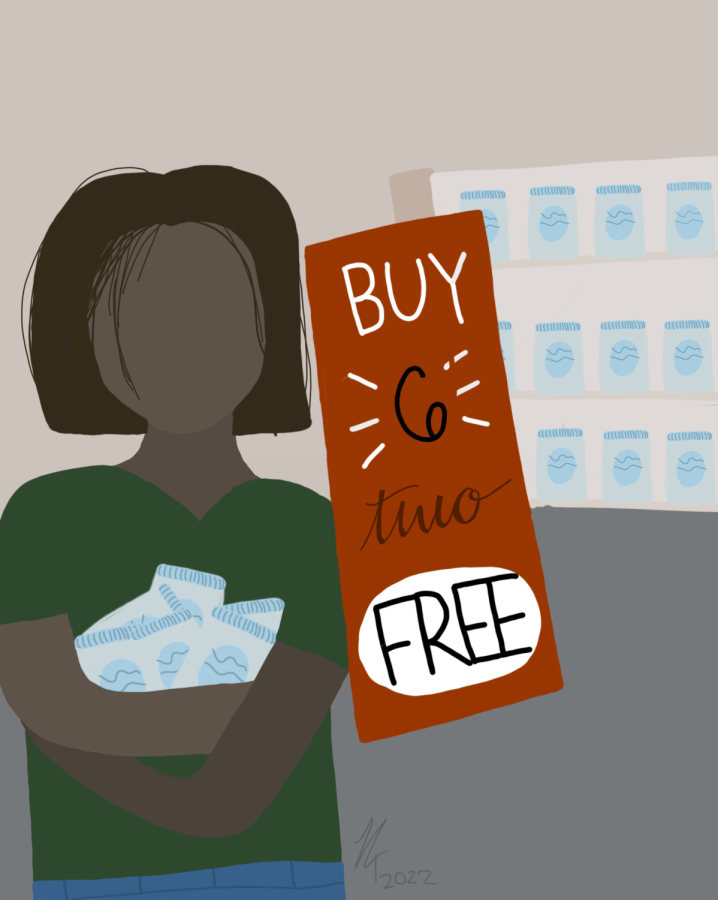Impulse Buys
October 6, 2022
As automated doors slide open, you enter your local grocery store, soft music and aromatic smells flooding your senses. You have a list of items, three simple objects, but as you head to the cashier, your arms are inundated with products.
Dubbed “impulse buys,” these ‘unexpected’ purchases are carefully sought after by stores, the vast majority of them tweaking elements of their business in an attempt to manipulate the consumer into purchasing more. Among these elements stand product placement and store layout. An article by Talk Business states, “Supermarkets know you will want milk, bread, and eggs. They will purposefully place these items to the back of the store.” The end goal? Wearing down consumers into purchasing more. With this layout, the customer ends up walking past non-essential, but highly attractive products multiple times, heightening the chance of them buying products they do not need. Junior Percy Colluru explains their experience with this, stating, “I find that PCC is especially good at this, because they have cute trees as soon as [I] go into the aisle, and I find that [those types of small, fun items] appeal to me.” Smaller products are also more “guilt-free,” with consumers finding it easier to rationalize spending money on a small item. Sophomore Zosia Milkowski adds, “It is more likely [that I will impulse buy] if I go into Fred Meyer or Safeway. But, it is not going to happen at Costco because I am aware of how much I am going to buy, since Costco sells their items in bulk.” Stores keep their product makeup and demographic in mind. Senior Ria Patil, an employee at Marshall’s, states how they do this: “The check-out line [at Marshalls] has so many different products, and people spend time in that line shopping for things.” Wait time allows for consumers to see the allure of various products near the cashier, and is one last attempt to induce the customer to purchase an item. Simultaneously, once one gets trapped in wait lines, it becomes time-consuming to return products, as leaving the queue means the customer gives up their spot and goes again from the end.
The marketing tactics do not just begin within the store; however, they are apparent even from the window displays of a building. Patil says, “We place teen clothing near the front of the store, because it is trendy and catches the eyes of [the younger demographic].” Simply piquing interest for consumers to step into a store can lead to increased sales.
With the gradual unveiling of these tactics, consumers become increasingly aware of the thought that stores put into their display in an attempt to nudge customers into purchasing more. Patil says, “[Even as an employee], I am still a victim of this.” Simply illustrating a portion of the thought stores put in is not enough – if a consumer truly wants to avoid impulse buys, they must start with this mindset. Patil adds, “After watching people buy a lot of things, and thinking about their costs, [I] think about what [I] really need and the cost of that.” This process can display itself in many different ways, but to Colluru it becomes a matter of asking the right questions. He states, “I do not think about preventing [impulse buys] much, I only [ask questions] to see if I can justify it. I ask if I have something similar, if I really need it, what I will use it for, so that even if I ‘impulsively’ buy it, I have a reason.” Of course, there are tips and tricks that can additionally help prevent impulse buys. Milkowski states, “Taking my mom with me to the grocery store helps me stay focused.” Having a pillar of reason on a trip can help circumvent excessive buys though, as Milkowski states, the wrong person may “exponentially multiply” the number of impulse buys one would make. Junior Arya Krishnamoorthy mentions a tip that circles back to the specific marketing strategies of retailers: “Do not look at the middle shelf, because they put the most expensive [products] there.” At eye level of the consumers, the middle shelf would be the most prevalently seen. This is confirmed by a study published in the National Library of Medicine, which states, “Overall, the results show that the target brand’s relative sales against its product category were higher when it was placed in the middle shelf compared to the high or low shelf.” Of course, an exception to this would be products marketed towards children, which would most likely be placed lower, closer to a level they could reach.
Stores employ a variety of tactics to engage customers and attempt to make them purchase more. As a customer, it is important to be aware of such attempts, and to not buy unnecessary things. Hopefully, the next time you visit a store, your three-item list will remain only three items as you walk out the door.



